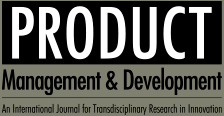Prioritization of Digital Innovation Team projects using a utility model and tradespace analysis
R. Chadwick Holmes, Zhao Zhang, Bradley Mallison, Sandra Saldaña, Jason Francis, Bryan R. Moser
Abstract
Firms outside of traditional software and internet technology disciplines face unfamiliar challenges in managing portfolios of innovative digital products as their industries are reshaped by digital transformation. When rapid prototyping of proofsof-concept (POCs) is the responsibility of a specialized Digital Innovation Team (DIT), the rate of idea creation can quickly outpace the capacity of this dedicated group. Systematically identifying and pursuing the highest-value ideas aligned with business needs, innovation goals, and enterprise strategy becomes both a vital and difficult technical challenge. This study examines a prioritization and selection (PAS) approach founded on systems engineering (SE) methods to manage the work progressed within a DIT. The assessment combines stakeholder analysis with surveys to characterize a multi-attribute utility function measuring POC benefit. POC resources are estimated from anticipated duration, development needs, validation requirements, and process change necessary for the technical solutions. These metrics characterize a cost-benefit trade-off, complemented by innovation measures associated with each POC. The proposed workflow supports portfolio shaping and work prioritization across different business segments while facilitating the stakeholder alignment and prototype visibility necessary to drive product commercialization. Future work will address a remaining gap in the consistent valuation of lower-benefit innovative work that is a foundational dependency for higher-value POCs.
Keywords
References
Bagno, R. B., Leiva, T. L., & de Oliveira, L. G. H. (2015). Innovation management: lessons learned from innovation diagnostic tools. Product: Management & Development, 14(1), 12-21. http://dx.doi.org/10.4322/pmd.2016.005.
Barthel, P., Perrot, C. M., Benlian, A., & Hess, T. (2021). Towards a method for evaluating digital innovation projects. In Proceedings of the 28th European Conference on Information Systems (pp. 1-11). Marrakesh, Morocco. A Virtual AIS Conference.
Bassi Padilha, J., Cziulik, C., & de Camargo Beltrão, P. A. (2017). Innovation potential assessment of conceptual design alternatives during PDP. Product: Management & Development, 15(1), 20-30. http://dx.doi.org/10.4322/pmd.2017.003.
Berghaus, S., & Back, A. (2017). Disentangling the fuzzy front end of digital transformation: activities and approaches. In Proceedings of the International Conference on Information Systems (ICIS) 2017 (pp. 1-17). Seoul. Retrieved in 2022, October 16, from https://aisel.aisnet.org/icis2017/PracticeOriented/Presentations/4
Birkinshaw, J., & Gibson, C. (2004). Building an ambidextrous organization. MIT Sloan Management Review, 45(4), 47-55.
Cameron, B. G., Crawley, E. F., Feng, W., & Lin, M. (2011). Strategic decisions in complex stakeholder environments: a theory of generalized exchange. Engineering Management Journal, 23(3), 37-45.
Clark, K. B., & Wheelwright, S. C. (1992). Organizing and leading “heavyweight” development teams. California Management Review, 34(3), 9-28.
Crawley, E., Cameron, B., & Selva, D. (2015). System architecture: strategy and product development for complex systems. Hoboken: Prentice Hall Press.
Edmondson, A. C., & Nembhard, I. M. (2009). Product development and learning in project teams: the challenges are the benefits. Journal of Product Innovation Management, 26(2), 123-138.
Frey, J., Holotiuk, F., & Beimborn, D. (2020). Debating digital innovation: a literature review on realizing value from digital innovation. In Proceedings of the 15th International Conference on Wirtschaftsinformatik (pp. 812-827). Potsdam, Germany. https://doi.org/10.30844/wi_2020_h3-frey.
Klünder, J. A.-C., Hohl, P., Prenner, N., & Schneider, K. (2019). Transformation towards agile software product line engineering in large companies: a literature review. Journal of Software: Evolution and Process, 31(5), e2168. http://dx.doi.org/10.1002/smr.2168.
Kniberg, H., & Ivarsson, A. (2012). Scaling agile@ spotify. UCVOF, Ucvox. Files. Wordpress. Retrieved in 2022, October 16, from Com/2012/11/113617905-Scaling-Agile-Spotify-11. Pdf
Kolm, P. N., Tütüncü, R., & Fabozzi, F. J. (2014). 60 Years of portfolio optimization: practical challenges and current trends. European Journal of Operational Research, 234(2), 356-371.
Kristiansen, J. N., & Ritala, P. (2018). Measuring radical innovation project success: typical metrics don’t work. The Journal of Business Strategy, 39(4), 34-41. http://dx.doi.org/10.1108/JBS-09-2017-0137.
Kurth, M., Keisler, J. M., Bates, M. E., Bridges, T. S., Summers, J., & Linkov, I. (2017). A portfolio decision analysis approach to support energy research and development resource allocation. Energy Policy, 105, 128-135.
Lerch, M., & Spieth, P. (2012). Innovation project portfolio management: a qualitative analysis. IEEE Transactions on Engineering Management, 60(1), 18-29.
Mankins, M., & Garton, E. (2017). How Spotify balances employee autonomy and accountability. Harvard Business Review, 95(1)
Miller, G. A. (1956). The magical number seven, plus or minus two: some limits on our capacity for processing information. Psychological Review, 63(2), 81-97. http://dx.doi.org/10.1037/h0043158.
Neumeier, A., Wolf, T., & Oesterle, S. (2017). The manifold fruits of digitalization-determining the literal value behind. In Proceedings of the 13th International Conference on Wirtschaftinformatik (pp. 484-498). St. Gallen, Switzerland.
O’Reilly 3rd, C. A., & Tushman, M. L. (2013). Organizational ambidexterity: past, present, and future. The Academy of Management Perspectives, 27(4), 324-338.
Oliveira, M. G., Bagno, R. B., de Sousa Mendes, G. H., Rozenfeld, H., & de Souza Nascimento, P. T. (2019). The Front-Hub of Innovation: updating the classic Fuzzy Front-End to the new approaches of innovation management. Product: Management & Development, 16(2), 81-91. http://dx.doi.org/10.4322/pmd.2018.013.
Ross, A. M., & Hastings, D. E. (2005). The tradespace exploration paradigm. INCOSE International Symposium, 15(1), 1706-1718. https://doi.org/10.1002/j.2334-5837.2005.tb00783.x.
Scaled Agile, Inc. (2021, February 10). WSJF: Scaled Agile Framework. Retrieved in 2022, October 16, from https://www.scaledagileframework.com/wsjf/
Van der Linden, F. J., Schmid, K., & Rommes, E. (2007). Software product lines in action: The best industrial practice in product line engineering. Springer Science & Business Media.
Wheelwright, S. C., & Clark, K. B. (1992). Creating project plans to focus product development. Harvard Business Review, 70(2), 70-82.
Ximenes, B. H., Alves, I. N., & Araújo, C. C. (2015). Software project management combining agile, lean startup and design thinking. In A. Marcus (Ed.), Design, user experience, and usability: design discourse (pp. 356-367). USA: Springer.
Submitted date:
11/14/2022
Accepted date:
12/05/2022

